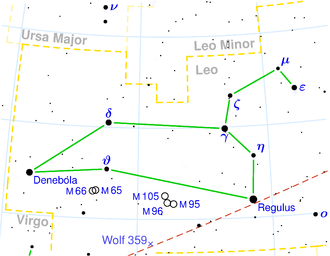NGC 3883
| Galaxy NGC 3883 |
|
|---|---|

|
|
| SDSS recording | |
| AladinLite | |
| Constellation | lion |
|
Position equinox : J2000.0 , epoch : J2000.0 |
|
| Right ascension | 11 h 46 m 47.2 s |
| declination | + 20 ° 40 ′ 32 ″ |
| Appearance | |
| Morphological type | SA (rs) b / RET |
| Brightness (visual) | 12.7 mag |
| Brightness (B-band) | 13.4 mag |
| Angular expansion | 2.8 ′ × 2.3 ′ |
| Position angle | 159 ° |
| Surface brightness | 14.6 mag / arcmin² |
| Physical data | |
| Affiliation | Leo cluster |
| Redshift | 0.023433 +/- 0.000013 |
| Radial velocity | 7025 +/- 4 km / s |
|
Stroke distance v rad / H 0 |
(312 ± 22) · 10 6 ly (95.6 ± 6.7) Mpc |
| history | |
| discovery | Wilhelm Herschel |
| Discovery date | April 13, 1785 |
| Catalog names | |
| NGC 3883 • UGC 6754 • PGC 36740 • CGCG 127-054 • MCG + 04-28-053 • 2MASX J11464719 + 2040312 • GC 2551 • H III 372 • LDCE 836 NED047 | |
NGC 3883 is a spiral galaxy of Hubble type Sb in Leo on the ecliptic . It is an estimated 312 million light years away from the Milky Way , about 260,000 ly in diameter, and is a member of the Leo Galaxy Cluster .
The galaxies NGC 3861 , NGC 3884 , NGC 3886 , IC 732 are located in the same area of the sky .
The object was discovered on April 13, 1785 by William Herschel .
